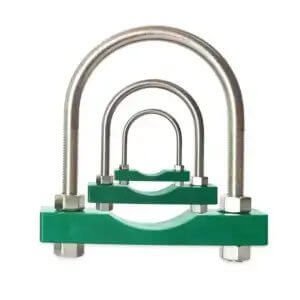U Bolt Customized U Clamp Supplier
1. Introduction
U-bolts are a common connecting component commonly used to connect metal components, especially in steel structures.
It is named after its U-shaped shape. A type bolt is composed of a screw, a washer, and a nut.
By threading the screw through the hole of the component and fixing it with a nut, the component is connected.

2. Structure and Materials
U Bolt Customized U Clamp Supplier High Qualiy,The main components of U-bolts include screws, washers, and nuts
2.1 Screw
The screw is the main part of the U-bolt and is usually made of high-strength alloy steel. The shape of the screw is cylindrical,
with one end threaded for fitting with the nut. The thread type of the screw can be selected according to specific needs, and common types include regular threads and thread shapes.
2.2 Washers
The washer is located between the screw and nut, playing a role in dispersing the load and increasing friction.
Washers are usually made of steel or rubber and have good pressure resistance and sealing performance.
According to actual needs, the shape of the washer can be a flat washer, an elastic washer, or a bent washer.
2.3 Nut
Nuts are a crucial component of U-bolts used to secure screws and components. Nuts are usually made of steel and have internal threads that match the threads of the screw.
There are various types of nuts, including ordinary nuts, high-strength nuts, self-locking nuts, etc.

3. Usage
When using U-bolts for connection, the following steps need to be followed:
3.1 Preparation work
Before starting to use U-bolts, it is necessary to prepare the required materials and tools. This includes U-bolts, washers, nuts, as well as tools such as wrenches and torque wrenches.
3.2 Installing screws
Firstly, thread the screw through the hole of the component, ensuring that the length of the screw is sufficient to pass through the component and leaving an appropriate length for installing the nut.
3.3 Installing washers and nuts
Install a washer at one end of the screw and tighten the nut. Ensure that the threads of the washer and nut match well with the screw, and that the nut does not loosen during tightening.
3.4 Tightening nuts
Use a wrench or torque wrench to gradually tighten the nut until the required tightening torque is achieved.
According to specific requirements, it may be necessary to use a torque wrench to ensure that the tightening torque of the bolts meets the design requirements.
3.5 Checking connections
After installing and tightening the bolts, the connections should be inspected. Ensure that the bolts and nuts are not loose and the connection is firm and reliable.
If looseness or other problems are found, they should be adjusted or replaced in a timely manner.
4. Application field
U-bolts are widely used in various fields, especially in the field of steel structures. Here are some common application areas
·In the field of architecture: used to connect steel structural components, such as beams, columns, frames, etc,
·Bridge field: used to connect bridge segments, piers, etc.
·Ship field: used to connect ship structures, ship plates, etc
·Mechanical equipment field: components used to connect mechanical equipment,
·Automotive field: used to connect automotive components such as engines, chassis, etc,
5. Advantages and precautions
The use of U-bolts for connection has the following advantages
·High strength: Due to the fact that screws are usually made of high-strength alloy steel, the connection strength is high and they can withstand large loads
· Convenient disassembly: Compared to welding and other connection methods, U-bolt connections are easier to disassemble, making it easier to repair and replace components
· Flexibility: U-bolts can be selected with different specifications and materials according to needs to adapt to different application scenarios.
When using U-bolts, the following precautions should be taken:
·Ensure that the quality of screws, nuts, and washers meets the requirements and avoid using damaged or low-quality components.
·During the installation process, it is necessary to ensure that the threads of the screw and nut are well matched to avoid being too tight or too loose.
·Select appropriate bolt specifications and tightening torque based on specific requirements.
·Regularly inspect the connections to ensure that bolts and nuts are not loose or damaged.
conclusion
U-bolts, as a common connecting component, are widely used in various fields. By using U-bolts correctly, reliable connections of components can be achieved,
improving the stability and safety of the structure. During use, attention should be paid to selecting appropriate materials and specifications,
correctly installing and tightening bolts, and regularly checking the connection status. By using U-bolts reasonably, engineering quality and service life can be effectively improved.

